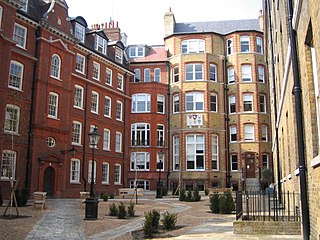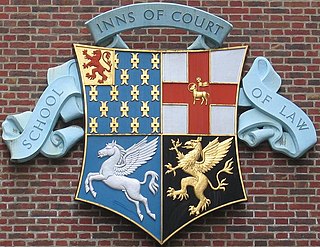
The Honourable Society of the Middle Temple, commonly known simply as Middle Temple, is one of the four Inns of Court entitled to call their members to the English Bar as barristers, the others being the Inner Temple, Gray's Inn and Lincoln's Inn. It is located in the wider Temple area of London, near the Royal Courts of Justice, and within the City of London. As a liberty, it functions largely as an independent local government authority.

The Honourable Society of the Inner Temple, commonly known as the Inner Temple, is one of the four Inns of Court and is a professional association for barristers and judges. To be called to the Bar and practise as a barrister in England and Wales, a person must belong to one of these Inns. It is located in the wider Temple area, near the Royal Courts of Justice, and within the City of London. As a liberty, it functions largely as an independent local government authority.

Fleet Street is a street in Central London, England. It runs west to east from Temple Bar at the boundary of the Cities of London and Westminster to Ludgate Circus at the site of the London Wall and the River Fleet from which the street was named.

The Inns of Court in London are the professional associations for barristers in England and Wales. There are four Inns of Court: Gray's Inn, Lincoln's Inn, Inner Temple and Middle Temple.

The Strand is a major street in the City of Westminster, Central London. The street, which is part of London's West End theatreland, runs just over 3⁄4 mile (1.2 km) from Trafalgar Square eastwards to Temple Bar, where it becomes Fleet Street in the City of London, and is part of the A4, a main road running west from inner London.

Temple is a London Underground station located at Victoria Embankment in the City of Westminster, close to its boundary with the City of London. It is on the Circle and District lines between Embankment and Blackfriars, and is in fare zone 1.

The Temple Church, a royal peculiar in the Church of England, is a church in the City of London located between Fleet Street and the River Thames, built by the Knights Templar for their English headquarters in the Temple precinct. It was consecrated on 10 February 1185 by Patriarch Heraclius of Jerusalem. During the reign of King John (1199–1216) it served as the royal treasury, supported by the role of the Knights Templar as proto-international bankers. It is now jointly owned by the Inner Temple and Middle Temple Inns of Court, bases of the English legal profession. It is famous for being a round church, a common design feature for Knights Templar churches, and for its 13th- and 14th-century stone effigies. It was heavily damaged by German bombing during World War II and has since been greatly restored and rebuilt.

Temple Bar was the principal ceremonial entrance to the City of London from the City of Westminster. In the middle ages, London expanded city jurisdiction beyond its walls to gates, called ‘bars’, which were erected across thoroughfares. To the west of the City of London, the bar was located adjacent to the area known as the Temple. Temple Bar was situated on the historic royal ceremonial route from the Tower of London to the Palace of Westminster, the two chief residences of the medieval English monarchs, and from the Palace of Westminster to St Paul's Cathedral. The road east of the bar within the City was Fleet Street, while the road to the west, in Westminster, was The Strand.

The Inns of Chancery or Hospida Cancellarie were a group of buildings and legal institutions in London initially attached to the Inns of Court and used as offices for the clerks of chancery, from which they drew their name. Existing from at least 1344, the Inns gradually changed their purpose, and became both the offices and accommodation for solicitors and a place of initial training for barristers.

Essex House was a house that fronted the Strand in London. Originally called Leicester House, it was built around 1575 for Robert Dudley, 1st Earl of Leicester, and was renamed Essex House after being inherited by his stepson, Robert Devereux, 2nd Earl of Essex, after Leicester's death in 1588. The poet Philip Sidney lived in Leicester House for some time.

Paper Buildings are a set of chambers located in the Inner Temple in Temple, London. They were initially constructed in 1609. Paper Buildings appear in A Tale of Two Cities and Barnaby Rudge.

The Outer Temple is a building next to the Temple area in London, just outside the City of London. In the 14th century, the property seized from the Knights Templar was divided, and that part of the Temple property then just outside London was given the name Outer Temple. It has been suggested that the name Outer Temple once also referred to an Inn of Chancery; its historical existence was first posited by A. W. B. Simpson and confirmed by John Baker in 2008. Little is known of it, other than that it lacked a hall; Baker suggests that this is the reason that it did not survive long enough to appear in many records. Other writers have insisted that it was never an inn: Sir George Buck wrote in 1612 "the Utter Temple neither is nor was ever any college or society of students". Regardless, although the present building takes the name, and is located in the area once known as outer-Temple, it is not otherwise historically connected.
The history of the Knights Templar in England began when the French nobleman Hugues de Payens, founder and Grand Master of the Order, visited the country in 1128 to raise men and money for the Crusades.

Pump Court is a courtyard in Temple, London, now primarily housing barristers' chambers. It is the first on the left in Middle Temple Lane from 6 Fleet Street, leading to Inner Temple Lane and Lamb's Buildings. Its name referred to the pump in the middle.

King's Bench Walk is a street in Temple, in the City of London. It is mainly made up of barristers' chambers.

Milford Lane is a narrow street in the City of Westminster that runs from Strand in the north to a brief walkway section leading to Temple Place in the south. It is joined by Little Essex Street and Essex Street on its eastern side. Maltravers Street once joined the lane to Arundel Street, but ceased to exist when building work at 190 Strand was completed.

Temple Place is a street in the City of Westminster that runs parallel with Victoria Embankment along the River Thames. The name of the street refers to the Knights Templar who once lived in the Temple area of London.
This is a list of the etymology of street names in the London district of Holborn. Holborn has no formally defined boundaries - those utilised here are: Theobald’s Road to the north, Gray's Inn Road and the City of London boundary to the east, Victoria Embankment/the Thames to the south, and Lancaster Place, the north-west curve of the Aldwych semi-circle, Kingsway/Southampton Row to the west.
The New Inn was one of the Inns of Chancery or Hospida Cancellarie. It existed from the late 15th century until 1902 and was located near Aldwych in London.





















